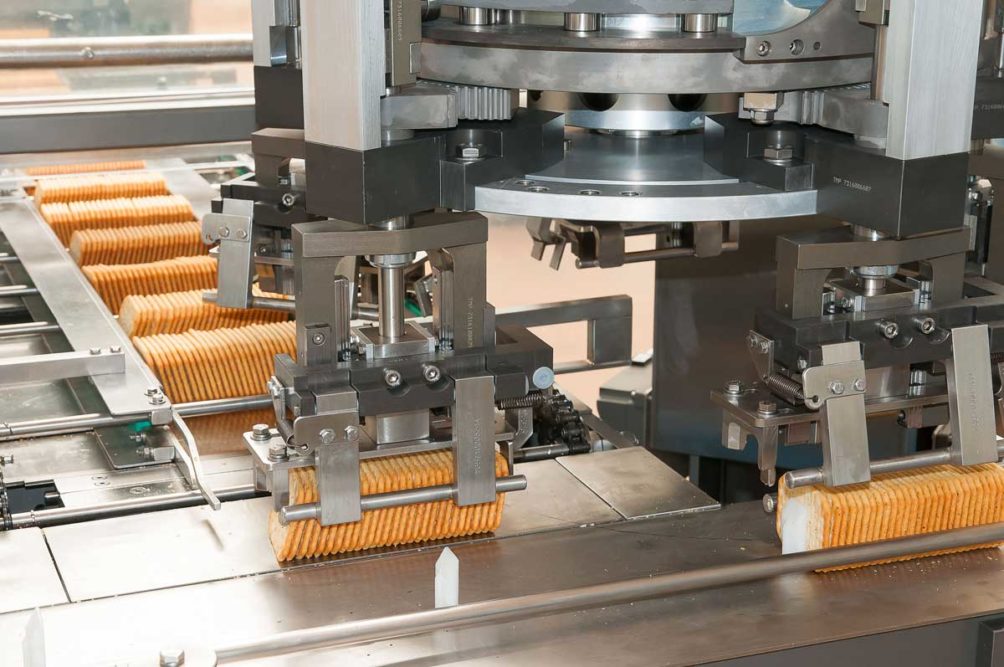To increase the capacity of their lines, many bakers and snack producers focus on increasing the speed. But sometimes to achieve the greatest overall efficiency, lines need to be slowed or tweaked when streamlining their horizontal form/fill/seal (h/f/f/s) operations.
The factors that can limit how fast product runs on h/f/f/s machines are product size and variance, film type and the seal. The forming step typically is the least critical, but filling a package with product is specific and can slow or increase the speed.
For example, softer and more flexible snack bars run slower, said Bill Kehrli, vice-president of sales and marketing at Cavanna Packaging. Sticky products can maintain a regular speed but must be managed to ensure they don’t touch one another. Although rigid products move quickly through h/f/f/s equipment, rigid and brittle products have constraints.
Consistency is key.
“The smaller and more consistent the product, the better,” said Angela McDaniel, marketing and sales coordinator, Formost Fuji. “If you have a product that is the same size all the time, the machine will run much faster.”
For every h/f/f/s order, Bosch Packaging Technology, asks its customers for engineering product samples to see the size and shape minimums and maximums. This allows engineers to make sure the equipment will have the flexibility to handle every potential variance in the product.
New in the past five years is h/f/f/s equipment’s flexibility to changeover to a completely new product, which in the past slowed down production immensely.
“Multiple s.k.u.s has been a growing trend for many years,” said Jason Angel, vice-president of sales and marketing at Ossid, a ProMach brand. “Small- to large-format machines are critical to fitting the processor’s applications.”
To achieve efficiency with h/f/f/s equipment, he advised companies to minimize changes in dimensions — as well as incorporate auto-loading and auto-case packing — when designing s.k.u.s.
The limits of film type and seal are typically intertwining. Run a product too fast with heat seal, and a film won’t stick together. Run a product too slow, and a heat seal could burn the film. Kelly Meer, product manager at Bosch Packaging Technology, said the temperature for the seal generally has a window of +/-5%. The outside of multilayered film should have a higher melting point than the inside so that the film doesn’t stick to the machine’s jaws and hinder production.
Mr. Meer compared heat-sealing h/f/f/s equipment with baking a cake.
“If you’re in a hurry, you can’t just turn the temperature up,” he noted. “But there are tricks to go faster. We have machines with what we call ‘long dwell’ or ‘extended dwell’ technology. We don’t increase the temperature, but we increase time.”
With a cold seal, however, the speed of products such as snack bars can easily be increased. Like a Post-It note, all it needs is pressure. This type of seal doesn’t work for every baked food or snack item, however, and it’s more expensive than heat seal.
Bakers and snack producers moving to sustainable packaging must also understand that the change may affect the speed and quality of a package. Dennis Gunnell, president, Formost Fuji, said that recyclable films not only don’t seal as fast, but the seal also won’t be recyclable or as secure.
Despite the good intentions, there will be tradeoffs, though this is an area that film manufacturers and others in the industry increasingly look to improve.
“Formable paper and semi-rigid compostable bio-resin are coming on strong, and we have to adapt to form and seal these materials,” Mr. Angel said. “Partnering with material providers is key to overcome these obstacles and provide the sustainable packaging people are expecting.”
This article is an excerpt from the November 2019 issue of Baking & Snack. To read the entire feature on horizontal form/fill/seal, click here.





